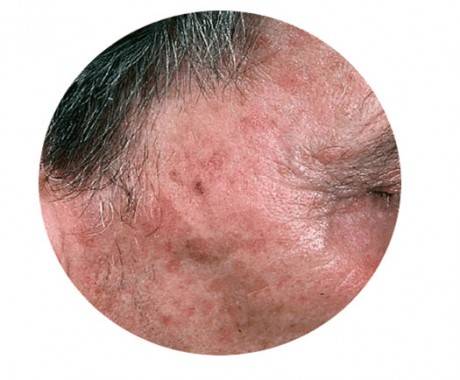Skin Cancer
Skin cancer is the most prevalent of all type of cancers. It is more common in people with fair skin, especially those who sunburn easily or who have spent extensive time in the sun.
Types of skin cancer and pre-cancerous lesions
Actinic keratosis (AK)
This pre-cancerous lesion feels like a gritty area and may be pink. It is usually only a few millimeters in size. If left untreated, it may develop into squamous cell carcinoma (SCC), a type of non-melanoma skin cancer; in fact, AK may represent "stage 0" SCC, a state called in situ (Latin for "in place.")
AKs are found on sun exposed areas such as the face, forearms, chest, and upper back. Generally if someone has AKs, they have multiple spots and will continue to have these. AKs can be treated by freezing (cryotherapy) with liquid nitrogen, with gels that stimulate the immune system (Aldara), or with a mild cream form of chemotherapy that destroys precancerous cells (Efudex/Efudix, 5-FU).
Basal cell carcinoma (BCC)
BCC is the most common type of skin cancer. It occurs often on face, but can occur anywhere, particularly in areas that are chronically sun-exposed. BCCs are frequently found in fair-skinned individuals; they are uncommon in dark-skinned individuals. Thee grow very slowly, usually as pink or shiny raised lesions. They may look like non-healing pimples. They rarely spread away from the original site, but they will continue to grow locally until they are removed by surgery. BCC is easily treated and the cure rate is very high - generally 95% - and therefore there is no risk to overall well being. However, individuals who have had a BCC are very likely to have an additional BCC in their lifetime and therefore need to have all of their skin checked yearly by a dermatologist.
Squamous cell carcinoma (SCC)
SCC is the second most common skin cancer. It is usually a slightly red and rough and is usually seen in fair-skinned individuals. SCC is more common in people whose immune system is compromised by illness or medications. Lesions of SCC are most often found on areas that are chronically sun-exposed, such as the face, ears, neck, lower legs, forearms, chest, and upper back, but they can occur anywhere. Like BCC, SCC is generally cured by surgery. Also like BCC, SCC usually grows locally, but it stands a slightly higher risk of spreading to other areas if left untreated.
Melanoma
Melanoma is the most deadly type of skin cancer. Melanoma begins in melanocytes, the cells of the skin that produce the pigment called melanin, which gives the skin its characteristic color and which allows the skin to tan. Moles (nevi) are benign growths of melanocytes, which everyone has. Melanomas, in contrast, are not benign, and can spread to other areas quickly. Therefore early diagnosis is of great importance.
Melanoma can develop as a new mole-like brown lesion, or it may develop in an existing mole, appearing as a change in the appearance of the mole. It is more common on areas that have been sunburned but may develop anywhere, even on sites that have never been exposed to the sun, like the sole of the foot, or under the nail. For unknown reasons, melanoma in these areas is more common in dark individuals. Rarely, melanoma is not brown or black, but rather appears as a new skin-colored or red lesion, like a non-healing pimple.
Any new or changing mole must be examined by a dermatologist. Early melanoma can be removed while still in the curable stage; melanoma metastasizes, making early diagnosis and treatment of great importance.
Screening for skin cancer
Since early detection improves the outcome of skin cancer treatment, it is strongly recommended that everyone monitor their skin for new or changing lesions regularly.
After age 30, any new lesion should prompt evaluation by a dermatologist.
The method for evaluating moles that may be suspicious for melanoma is called the ABCD rule. Most dermatologists add an "E.":
A Asymmetry: one half unlike the other half
B Border: irregular, scalloped or poorly defined border may be a sign of melanoma
C Color: moles that have more than one color or that are different in color from the other moles should prompt close attention
D Diameter: moles that are more than 6mm may be more suspicious, though melanoma can be of any size
E Evolution: any change (including disappearance of a mole, crusting, or bleeding) or new lesion, especially after age 30, should be checked by a dermatologist.
Treatment
If a skin biopsy reveals cancer, the dermatologist may choose from an array of medical and surgical treatment procedures depending upon the type of cancer, its size and location, and the needs of the individual.
Reducing the risk of skin cancer
Sun exposure is the most preventable risk factor for all skin cancers, including melanoma.
How to minimize your sun exposure:
- Generously apply a broad-spectrum water-resistant sunscreen with a high Sun Protection Factor (SPF) to all exposed skin. "Broad-spectrum" provides protection from both ultraviolet A (UVA) and ultraviolet B (UVB) rays. Re-apply approximately every two hours, even on cloudy days, and after swimming or sweating.
- Wear protective clothing, such as a long-sleeved shirt, pants, a wide-brimmed hat and sunglasses, where possible.
- Seek shade. Remember that the sun is strongest between 10 a.m. and 4 p.m.
- Protect children from sun exposure by playing in the shade, using protective clothing and applying sunscreen.
- Use extra caution near water, snow and sand as they reflect the sun.
- Do not use tanning beds. If you want to look like you've been in the sun, try a sunless self-tanning product.
Adapted from the American Academy of Dermatology
The information above is a partial and general information and cannot replace the needed specific medical examination and consultation

